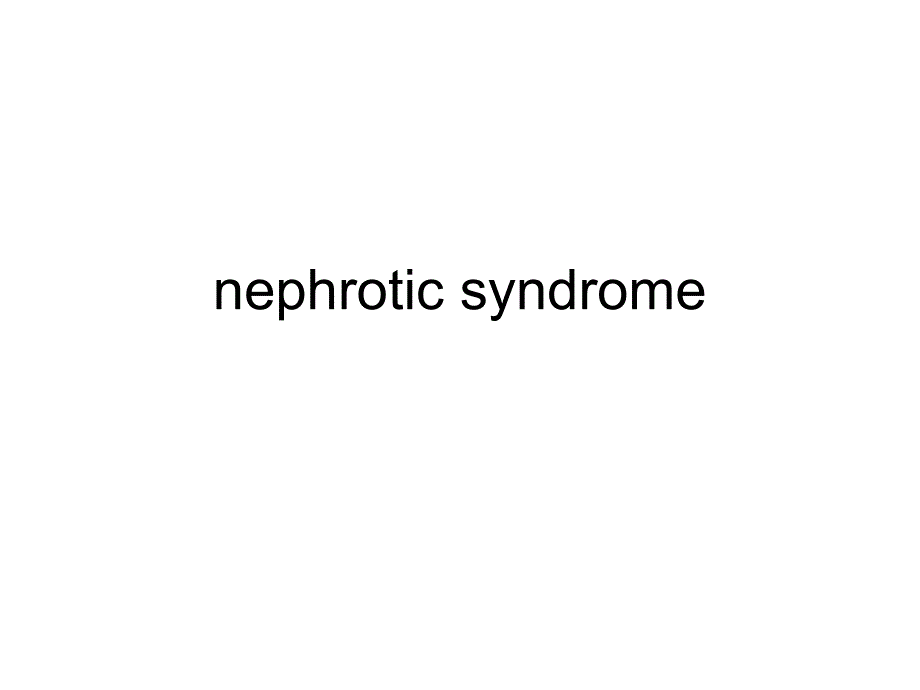 儿科学教学课件:nephrotic syndrome1
儿科学教学课件:nephrotic syndrome1



《儿科学教学课件:nephrotic syndrome1》由会员分享,可在线阅读,更多相关《儿科学教学课件:nephrotic syndrome1(35页珍藏版)》请在装配图网上搜索。
1、nephrotic syndrome Approximately 90%of children with nephrotic syndrome have idiopathic nephrotic syndrome.The remaining 10%of children with nephrotic syndrome have secondary nephrotic syndrome related to systemic or glomerular diseases.systemic diseases such as systemic lupus erythematosus,Henoch-S
2、chnlein purpura,malignancy(lymphoma and leukemia),and infections(hepatitis,HIV)A number of hereditary proteinuria syndromes are caused by mutations in genes that encode critical protein components of the glomerular filtration apparatus PathologyMinimal change nephrotic syndrome(85%)Mesangial prolife
3、ration(5%)Focal segmental glomerulosclerosis(10%)These 3 disorders may represent 3 separate diseases with a similar clinical presentation;alternately,these disorders may represent a spectrum of a single disease.Clinical manifestationEdema Foamy urineAbdominal painDiarrhea.ascites,pleural effusions,a
4、nd genital edema.hypertension and gross hematuria are uncommon.The idiopathic nephrotic syndrome is more common in boys than in girls(2:1)and most commonly appears between the ages of 2 and 6 yrThe initial episode of idiopathic nephrotic syndrome,as well as subsequent relapses,usually follows minor
5、infections and,uncommonly,reactions to insect bites,bee stings,or poison ivy.The differential diagnosis of the child with marked edema includes protein-losing enteropathy,hepatic failure,heart failure,acute or chronic glomerulonephritis,and protein malnutrition.DiagnosisUrinalysis:proteinuriaSpot ur
6、ine protein/creatinine ratioUrinary protein excretionSerum albuminSerum cholesterol and triglyceride The urinalysis reveals 3+or 4+proteinuria Spot urine protein/creatinine ratio exceeds 2.0 urinary protein excretion exceeds 3.5 g/24 hr in adults and 40 mg/m2/hr in childrenThe serum albumin level is
7、 generally 2.5 g/dL,and the serum cholesterol and triglyceride levels are elevated.TreatmentSodium restriction and fluid restriction Sodium intake should be reduced by the initiation of a low-sodium diet and may be normalized when the child enters remission.oral diuretics are used by many clinicians
8、 for children with nephrotic syndrome.Because of the possibility of increasing the risk of thromboembolic complications,diuretic use should be reserved for patients with severe symptoms and must be closely monitored.IV administration of 25%human albumin(0.5 g/kg/dose q 612 hr administered over 12 hr
9、)followed by furosemide(12 mg/kg/dose IV)is often necessary when fluid restriction and parenteral diuretics are not effective.Children with onset of nephrotic syndrome between 1 and 8 yr of age are likely to have steroid-responsive MCNS;steroid therapy may be initiated without diagnostic renal biops
10、y.Children with features that make MCNS less likely(hematuria,hypertension,renal insufficiency,hypocomplementemia,age 8 yr)should be considered for renal biopsy before treatment.In children with presumed MCNS,prednisone should be administered(after confirming a negative PPD test)at a dose of 60 mg/m
11、2/day(maximum daily dose,80 mg divided into 23 doses)for at least 4 consecutive weeks.After the initial 6-wk course,the prednisone dose should be tapered to 40 mg/m2/day given every other day as a single morning dose.The alternate-day dose is then slowly tapered and discontinued over the next 23 mo.
12、Many children with nephrotic syndrome experience at least 1 relapse(3-4+proteinuria plus edema).Although relapse rates of 60-80%have been noted in the past,the relapse rate in children treated with longer initial steroid courses may be as low as 30-40%.Relapses should be treated with 60 mg/m 2/day(8
13、0 mg daily max)in a single am dose until the child enters remission(urine trace or negative for protein for 3 consecutive days).The prednisone dose is then changed to alternate-day dosing as noted with initial therapy,and gradually tapered over 4-8 wk.A subset of patients will relapse while on alter
14、nate-day steroid therapy or within 28 days of stopping prednisone therapy.Such patients are termed steroid dependent.Patients who respond well to prednisone therapy but relapse 4 times in a 12-mo period are termed frequent relapsers.children who fail to respond to prednisone therapy within 8 wk are
15、termed steroid resistant.Steroid-resistant nephrotic syndrome is usually FSGS(80%),MCNS(20%),and rarely mesangial proliferative.Steroid-dependent patients,frequent relapsers,and steroid-resistant patients are candidates for alternative therapies,particularly if the child has severe corticosteroid to
16、xicity (cushingoid appearance,hypertension,cataracts,and/or growth failure).Cyclophosphamide high-dose pulse methylprednisolone.Cyclosporine tacrolimus Mycophenolate Angiotensin-converting enzyme (ACE)inhibitors and angiotensin II blockers may be helpful as adjunct therapy to reduce proteinuria in s
17、teroid-resistant patients.COMPLICATIONS Infection is the major complication of nephrotic syndrome.Spontaneous bacterial peritonitis Children with nephrotic syndrome are also at increased risk of thromboembolic events.The incidence of this complication in children is 2-5%,which represents a much lowe
18、r risk than that of adults with nephrotic syndrome.To minimize the risk of thromboembolic complications,aggressive use of diuretics and the use of indwelling catheters should be avoided if possible.Hyperlipidemia,particularly in patients with complicated nephrotic syndrome,may be a risk factor for c
19、ardiovascular disease.PROGNOSIS The majority of children with steroid-responsive nephrotic syndrome have repeated relapses,which generally decrease in frequency as the child grows older.Children with steroid-resistant nephrotic syndrome,most often caused by FSGS,generally have a much poorer prognosis.These children develop progressive renal insufficiency,ultimately leading to end-stage renal disease requiring dialysis or kidney transplantation.Recurrent nephrotic syndrome develops in 30-50%of transplant recipients with FSGS.
- 温馨提示:
1: 本站所有资源如无特殊说明,都需要本地电脑安装OFFICE2007和PDF阅读器。图纸软件为CAD,CAXA,PROE,UG,SolidWorks等.压缩文件请下载最新的WinRAR软件解压。
2: 本站的文档不包含任何第三方提供的附件图纸等,如果需要附件,请联系上传者。文件的所有权益归上传用户所有。
3.本站RAR压缩包中若带图纸,网页内容里面会有图纸预览,若没有图纸预览就没有图纸。
4. 未经权益所有人同意不得将文件中的内容挪作商业或盈利用途。
5. 装配图网仅提供信息存储空间,仅对用户上传内容的表现方式做保护处理,对用户上传分享的文档内容本身不做任何修改或编辑,并不能对任何下载内容负责。
6. 下载文件中如有侵权或不适当内容,请与我们联系,我们立即纠正。
7. 本站不保证下载资源的准确性、安全性和完整性, 同时也不承担用户因使用这些下载资源对自己和他人造成任何形式的伤害或损失。
相关资源
更多![[江苏]2023年滨海农商行新春大学生社会实践招募考前押密卷3套500题【附带答案详解】](/Images/s.gif) [江苏]2023年滨海农商行新春大学生社会实践招募考前押密卷3套500题【附带答案详解】
[江苏]2023年滨海农商行新春大学生社会实践招募考前押密卷3套500题【附带答案详解】
 2023年江苏省淮安市涟水县石湖镇楼庄村社区工作人员考试模拟题及答案
2023年江苏省淮安市涟水县石湖镇楼庄村社区工作人员考试模拟题及答案
 2016年快餐业现状研究及发展趋势
2016年快餐业现状研究及发展趋势
 泛在学习的内涵与特征解构
泛在学习的内涵与特征解构
 泵站技术管理办法机电设备运行管理办法
泵站技术管理办法机电设备运行管理办法
 2023年校园开展法制宣传活动的总结(3篇).doc
2023年校园开展法制宣传活动的总结(3篇).doc
![[广东]2022年广东华兴银行总行社会招聘(1231)考前押密卷3套500题【附带答案详解】](/Images/s.gif) [广东]2022年广东华兴银行总行社会招聘(1231)考前押密卷3套500题【附带答案详解】
[广东]2022年广东华兴银行总行社会招聘(1231)考前押密卷3套500题【附带答案详解】
![[广东]2022年广东华兴银行营运管理部社会招聘(819)考前押密卷500题【3套附带答案详解】](/Images/s.gif) [广东]2022年广东华兴银行营运管理部社会招聘(819)考前押密卷500题【3套附带答案详解】
[广东]2022年广东华兴银行营运管理部社会招聘(819)考前押密卷500题【3套附带答案详解】
![[广东]2022年广州农商银行黄埔支行对公客户经理社会招聘(82)考前押密卷3套500题【附带答案详解】](/Images/s.gif) [广东]2022年广州农商银行黄埔支行对公客户经理社会招聘(82)考前押密卷3套500题【附带答案详解】
[广东]2022年广州农商银行黄埔支行对公客户经理社会招聘(82)考前押密卷3套500题【附带答案详解】
![[广东]2022年珠海华润银行社会招聘(311)考前押密卷3套500题【附带答案详解】](/Images/s.gif) [广东]2022年珠海华润银行社会招聘(311)考前押密卷3套500题【附带答案详解】
[广东]2022年珠海华润银行社会招聘(311)考前押密卷3套500题【附带答案详解】